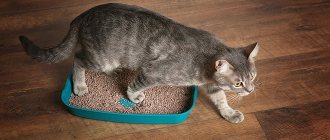What will you learn from the article?
- How to teach a kitten to sharpen its claws Step 1 Choose a scratching post
- Step 2 Restrict access
- Step 3 Choose a location
- Step 4 Increase Interest
When a kitten or an adult cat appears in the house, the owner becomes responsible for the new pet, its care and education. One of the main desires of the owner is to protect the furniture from damage.
- In this article we will tell you in detail how to train a cat to use a scratching post.
- Let's share some useful training tips.
- We'll show you how to quickly and easily teach a cat to sharpen its claws on a scratching post.
How to teach a kitten to sharpen its claws
The younger the kitten, the easier it is to train him. Kids quickly grasp everything and develop habits.
To ensure your kitten understands what you want from him, be consistent in your actions and be patient. Next, we will tell you step by step how to accustom a kitten to a scratching machine.
Step 1 Choose a scratching post
One important rule applies here - you choose not for yourself, but for your pet. There is no need to select this item to match the interior design of the apartment, choose models that visually appeal to you. If the kitten doesn't like the scratcher, the owners are doomed to failure.
- Give preference to tall models. The cat should be able to stretch and scratch as high as possible.
- If you bought a wall-mounted model of a scratcher, hang it so that while standing on its hind legs, the cat can fully extend its front legs over its head.
- Buy sustainable models. If the kitten feels that the scratching post is wobbly or shifting, he may become afraid and refuse to use it.
- Choose a texture that your pet will like. If the kitten likes to scratch the carpet, carpet options are suitable. If you're not sure what's right, try scratching posts with natural rope wrapped around a pole or corrugated cardboard models.
- Avoid models made of synthetic fibers and ropes, they create static electricity, which repels cats.
- Give your pet the opportunity to choose, purchase several accessories with different textures.
We recommend reading the article about which scratching post for cats to choose.
Step 2 Restrict access
Limit the animal's access to the areas it chooses to sharpen its claws.
- Cover upholstered furniture (sofas and armchairs) with covers, a heavy blanket or plastic wrap.
- Remove carpets or treat them with a citrus-scented spray; cats don’t like it.
- Wrap the scratched area with food foil or double-sided tape. Animals find it unpleasant to touch foil and sticky surfaces.
- Before leaving home, close rooms with upholstered furniture that the pet has chosen for sharpening its claws.
- Place the claw clipper directly in front of the object that the kitten likes to scratch.
Step 3 Choose a location
Choosing the location of the nail clipper is an important step in the training process. Scratching posts should be placed in areas suitable for cats. There is no need to put them in a corner or hide them in hard-to-reach places. This is convenient for owners, but cats will not like it. Place it where it is convenient for your cat to use it as a “territory marker.”
- Place it at the front door, under the window and in the place where the pet has chosen the place for sharpening its claws.
- If your cat likes to stretch and sharpen its claws after waking up, place a horizontal nail polisher where the cat likes to sleep.
- Watch the animal. If it sharpens its claws on vertical surfaces, place the nail clipper vertically. If your pet likes to sharpen its claws on carpets, place a horizontal model.
Place several scratching posts in different places. This will make it more likely that your cat won't touch your furniture or rugs.
Step 4 Increase Interest
The last step is to increase interest and draw attention to the scratching surface.
- To attract your cat to a new object, you can spray the scratching post with special training agents.
- You can increase the attractiveness of a new item for a cat with the help of valerian. A few drops of the product are enough to smear on the scratching post.
- Catnip has a similar effect, the smell of which drives kittens and adult cats crazy. Simply sprinkle dried mint on the base and top of your nail clipper.
- Engage with games and toys. Play with your kitten next to the scratching post. Decorate it with feathers or light balls for your pet to play with. So, during the game, the baby will understand that this object is convenient for sharpening his claws.
- Try placing the column sharpener on its side. This will make it easier for little kittens to get to know her. When they get used to it, place the post vertically.
- Praise your cat every time he uses this item for its intended purpose.
- Offer your pet's favorite treat when he places his paws on the nail sharpening surface. Give a treat every time the kitten sharpens its claws in the right place. Treats will help create a positive mood in the animal and the training process will go faster.
- You can attract attention by borrowing this cat accessory from your friends. The kitten will smell someone else's smell and will try to interrupt it by scratching the surface that retains the smell of another animal.
- Gently place your kitten's paws on the scratching surface and make a scratching motion. Be calm at this moment, speak kindly to the kitten.
The more often the kitten scratches the scratching post, leaving its smell, the more attractive this item will become for the pet.
Optimal house arrangement
In order for a pet to recognize a new home, it must meet special cat standards:
- Dimensions . A cat needs comfort and protection, so you need to carefully select housing according to the size of your pet. If the house is cramped or too large, the animal will refuse to spend the night in it.
- Quality of material . There is no need to save; preference is given to frames made from natural components - wood. Make sure that the upholstery fabric is soft, pleasant to the touch, and does not electrify, otherwise your pet will refuse to live in the house. Plush and carpet are the most acceptable; other natural fabrics can also be used. Synthetic padding and foam rubber are used as padding for the bed. A good option would be a homemade mattress made from familiar materials. Use an old shirt or robe that your pet likes to lie on. If he has a familiar bedding, move it into the house, making it easier to get used to.
- Smell . Before purchasing, sniff the house. There should be no strong odors; do not forget that a pet’s sense of smell is sharper than a human’s. If the housing emanates aromas of glue and low-quality materials, the fluffy will refuse to enter it.
- Sustainability . Cats are frightened by shaky structures, so check the security of the housing and secure it carefully. If an animal gets scared once in the house, it will ignore it in the future.
- Installation location . Place your pet's home in a secluded corner, not in the aisle. Cats love it when there is a radiator nearby - this provides comfort in winter, but you should not place the structure too close to the heating device - overheating causes molting.
- Emergency exits . The instinct of a predator makes fluffies care about their safety, so a house with several holes will be to their liking.
- Ventilation . Cats love ventilated rooms, so that unpleasant odors do not accumulate, and a comfortable temperature in summer and winter.
- Functionality . Pets are attracted not only by cozy, but also interesting designs - cats are very curious. It could be a multi-story structure with labyrinths. The pussy will be interested in an open complex with a scratching post. Metal parts will not only attract attention, but also ensure the stability and safety of the structure.
- Gender characteristics . Consider the gender of the cat when choosing a design. Males, by nature, must control the surrounding space, so houses on stands, with several tiers in height, are suitable for them. Females care for their young and tend to live in cozy, enclosed spaces.
Features of training depending on the age of the kitten
1-1.5 months
At this age, patience and cat treats will be your helpers.
- Take the kitten's favorite treat and call him to the scratching post.
- Raise the treat over the kitten so that he reaches for it and puts his paws on the scratch pad.
- Praise him for this and give him a treat.
- Stroke and talk affectionately.
- Repeat these steps until the baby learns to sharpen his claws in the right place.
2-2.5 months
Grown-up kittens are trained in the form of a game. They attract attention with the help of toys and show how to sharpen their claws. The owner’s main goal is to show the pet that this new item can be fun to play with. Positive results are rewarded with praise and treats.
4-5 months
As kittens mature, they develop their own preferences and form habits. The main efforts of the owner of such a kitten should be aimed at combating scratching of furniture and carpets. Inappropriate places for scratching should be made unattractive and repulsive. And attract attention to the scratching post with sprays or other scents that cats like (catnip, valerian).
Video
What to do if it doesn't work out
Have you tried all the methods to house train your cat, but your pet refuses to sleep there? Think about what the reason might be.
- You're in too much of a hurry. You may have given your cat too little time to adapt.
- After unsuccessful attempts, you scolded your pet near the house. In this case, the cat may develop negative associations with this place. The same thing can happen when you push your pet into a house too persistently and don’t let him get out.
- You have chosen the wrong place for the house (for example, the animal is not warm enough or the place is in a draft). Try changing its location and monitor your pet's behavior. Use the same methods, but in a new place, perhaps the cat was simply uncomfortable there.
- The structure of the house is shaky. This may also be the reason why cats are afraid of such structures. Try securing or rearranging the house so that it becomes stable.
- The cat is uncomfortable. The house may be too big or too small.
- The cat is repelled by the smell. Pets don’t like the strong smell; be sure to take this point into account when purchasing.
Try to avoid mistakes right away, because later you will have to destroy the negative associations of the animal with the new house. Of course, this will be more difficult than just teaching. It is important that the cat remembers the house on the good side.
How to train an adult cat to use a nail sharpener
If you need to train an adult cat that picks wallpaper, furniture and carpets, you will have to be patient. Adult animals are self-sufficient. They will not tolerate you picking up their paws and using them to scratch the surface to sharpen their claws. This will scare the pet away and he will avoid the scratching post. This training method only works with small kittens.
What can help with training?
- You can try treating the surface of the nail clipper with sprays with an attractive scent.
- Borrow a scratching post from your neighbors. An adult animal will try to cover up someone else's smell with its own.
- To attract your cat's attention, sprinkle dried valerian or catnip onto a scratching post and rub the herb into the scratching surface.
- Offer your cat a large size scratcher; small models can be ignored by adult pets without showing interest in them.
- Cover the areas your cat chooses to scratch with bubble wrap. The sound of popping bubbles scares away animals.
- Every time your pet shows interest in the scratcher, praise him and reward him with a treat.
Video
Method three: light pressure plus encouragement
A particularly stubborn cat must be housetrained with gentle pressure. Take the cat (do it softly and affectionately) and put it in the house. Caress her, give her a treat, but don’t insist too much, don’t try to keep her there by force. Just repeat this procedure from time to time, and soon the cat will begin to perceive the house as a place where it feels comfortable.
Video: how to house train a kitten
All cats are individual - some begin to sleep in the house from the day of purchase, and there are those that never recognize their new home. In any case, remember - a cat cannot be forced to do something. Only affection and encouragement (and sometimes cunning) will help convince the purr to do your way.
How to accustom a cat to a new scratching post
If you bought a new scratching post, but your cat ignores it and doesn’t understand what this item is for, use our tips:
- Spray the new item with catnip solution or a special training product.
- Pet your pet with a piece of fabric, tie a scarf with a scent to a post, this will increase interest in the purchase. Cats are not afraid of things with their own scent.
- Pet someone else's cat with a handkerchief and attach the handkerchief to the panel. Your pet will not tolerate someone else's smell; it will try to get rid of it by tearing off the handkerchief with its claws.
- If the pet does not show interest in the new product, try moving it to another place. Place it under the window, where the cat is used to watching what is happening on the street and spying on birds. Excitement encourages scratching.
Method one: take it out of curiosity
Although the tailed ones are conservative, no one has canceled the cat’s curiosity. A new object in the house will definitely interest the cat, and the owner’s task is to reinforce this interest. This can be done by placing the purr's favorite treat or her favorite toy inside the new home. Do this regularly and your cat will develop a positive association with the house. At first she will simply visit it from time to time, and over time she will begin to sleep in it - at first from time to time, and then constantly.
Tips for training a scratching post
10 effective tips that will lead you to success:
- Offer your cat different models (by location, texture). This way you will find one that the animal likes.
- Move the scratching post around until you find a spot that interests your cat the most.
- Patiently repeat the attempts, bringing the cat to the scratcher several times a day. Try to catch the moment when the animal just woke up. After sleep, most cats stretch and scratch with their claws.
- Purchase several models of different textures and orientations (horizontal, vertical, angular, oblique). The cat must have a choice.
- If a cat scratches its claws in the wrong place, you need to strictly tell it “no”, teaching it to the command, and take the pet to a place where it can scratch. Screaming and being an animal is unacceptable!
- Choose a model of the correct height. The cat must be able to stretch its spine - this is one of the reasons for scratching. Models that are too low are not suitable for this.
- Start training to use a nail clipper from a very early age.
- Make sure the fastening is secure. Buy models with a stable base or attach it to the floor. Cats are afraid of scratching posts that swing under the weight of the animal.
- For each animal in the house there should be at least two places for sharpening claws.
- Treat all scratchable surfaces with synthetic pheromones.
Basic requirements for a cat's home
In order to tame a cat to a place without any problems, it must meet certain requirements.
Size
How to train a puppy to sleep in his place alone at night
Any size bed will suit a kitten, but it is worth considering that as it gets older, it may be necessary to buy a new home. The cat should be comfortable in its place, and for this it should not be cramped. The ideal size of the house is slightly larger than the animal itself.
Material
It is recommended to choose soft houses with a stable bottom. This is important because cats don't trust unstable floors. You can use an ordinary cardboard box as a home, but it must be upholstered with fabric and a soft blanket or lounger placed on the bottom.
Important! The shape and type of the house is chosen individually.
The modern market offers a wide choice. This could be a regular booth house, a built-in house, a hammock, or a full-fledged play complex. It all depends on the personal preferences of the owners.
Tools for accustoming to a scratching post
The pet industry offers veterinary products for accustoming dogs to scratching posts. Use them to speed up learning and increase your animal's interest in the subject.
The best training tools:
- Spray Ms.Kiss. Price: 170 – 180 rub.
- Mr. Fresh Expert. Spray for scratching post. Price: 230 – 280 rub.
- Spray STOP problem. Price: 115 – 180 rub.
- Apicenna smart spray. Price: 250 – 290 rub.
- Comfort clawed trainer. Spray. Price: 170 – 180 rub.
- Matatabi, Japan Premium Pet. Powder to attract a cat's attention. Price: 200 – 240 rub.
- Catty Home, Beaphar. Drops for treating scratching posts. Price: 440 – 600 rub.
- Catnip, Beeztees. Dried catnip. Price: 150 – 210 rub.
What measures should not be used when training a cat?
You cannot hit or scream at your cat if it has once again tested the strength of the sofa. The pet will be scared, but it is unlikely to understand why they are angry with him. It’s better to say sternly: “You can’t,” and hit the floor with a slipper or clap your hands. The animal will be wary and understand that this is not worth doing.
Attention! Cats are vindictive by nature. For any aggression in their direction, they are ready to commit meanness. If you yell at her or hit her, for example, she may relieve herself on the bed.
You should not spray your cat with water from a spray bottle when it begins to sharpen its claws. Of course, contact with water is unpleasant for a pet, which means contact with a carpet, sofa or something else into which its claws have previously dug will be associated with danger that should be avoided. However, this method can hardly be called humane.
Important! Sometimes cats sharpen their paws not because they feel the need. They strive to attract attention because they remember that after damage to furniture or a carpet, people start yelling at them.
To help pet owners - a convenient and free Petstory service
Online consultations with the best veterinarians, making an appointment, quickly searching for the nearest veterinary clinic or pet store, a lot of useful information about the breeds of pets, about the proper upbringing, care, maintenance, treatment of pets - all this will be at your fingertips with Petstory.
https://koshkamurka.ru/4965-priuchenie-kotyonka-k-mestu-dlya-sna.htmlhttps://murkoshka.ru/povedenie/kak-priuchit-koshku-k-domiku.htmlhttps://www.poznavayka. org/zoologiya/train-kitten-to-place-for-sleep/
Choosing the right bed is half the success
The first step to accustom your cat to a bed is to provide a comfortable place to rest. The choice of bed is of enormous importance, since cats value comfort very much. First, determine the place where the bed will be placed; it should be remote, calm and dark. In the first days of training, it is wise to place the bed in your bedroom to make the cat feel calmer.
When choosing a suitable bed, you need to consider several factors:
Cats need space and like to toss and turn and stretch, so the bed should be large. Experience shows that cats ignore accessories that make it inconvenient to turn around or turn over on the other side.
By observing your pet, you can find out in which positions he prefers to sleep. If your cat often curls up into a ball, you need to choose a basket or round bed with sides.
Think about hygiene issues in advance. Choose an accessory, give preference to models with removable covers that are easy to wash. In addition to regular washing, it is necessary to regularly remove hair and dirt from covers.
Many owners consider only beds that are upholstered in woolen fabric to be good.
In fact, it is important to choose a bed that is covered with a natural material that does not create static tension (not necessarily wool). The filler plays an equally important role.
All of the above factors are not important if the cat does not feel safe. To properly equip a resting place, watch your pet; many cats prefer to sleep “under the roof”, in which case it is better to place the lounger under a table or bed. Another great option for secretive animals is a house.
Recommendations from experts
First, you need to wean your cat from sharpening furniture. There are special sprays for this.
And you should try to accustom him to the scratching post with the help of games.
Make a bow on a string, and when the cat is chasing it, put it on the scratching post - the cat should like it.
Evgenia Aleksandrova
https://forum.koschki.ru/index.php/topic/34-kak-priuchit-vzrosluiu-koshku-k-kogtetochke/
Encourage every time you see the scratching post being used: if you sharpen it, you get a treat, you praise it, you pet it. I tried to approach the sofa - they shushed me, slammed me with a newspaper, and sprayed me with a spray bottle. During the day, you can cover the armrests of the sofas with something like large towels/bedspreads so that it is inconvenient for him to touch them. In the meantime, someone is at home, watch, listen. Gradually, a reflex will form that the sofa is a nuisance, and the scratching post is a pleasure. Well, look for yourself: if the apartment is large, then it makes sense to install several scratching posts so that it is always at hand (under the paw, in the sense). Catnip and other baits will also play a role, but your behavior will matter more.
Mrss
https://www.u-mama.ru/forum/family/pets/714922/
Many cats do not like small scratching posts - it should be 65 - 70 centimeters high - otherwise the cat will not be able to stand on its hind legs and stretch out. When caught in the act of a crime, you take him to the scratching post and scratch it with his paws. Treat the scratching post with catnip and show it to the cat; many people react well to mint. Many people love corner scratching posts. When you leave, you can put a cover made of polyethylene film on the sofa. Or, leaving the cat alone, close the room - his bed is in the corridor, let him go to the kitchen to eat, to the toilet, and that’s it.
OAya
https://www.u-mama.ru/forum/family/pets/714922/









